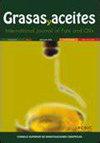UV/TiO2工艺降解月见草油中部分挥发性化合物
IF 1.1
4区 农林科学
Q4 CHEMISTRY, APPLIED
引用次数: 0
摘要
难闻的味道是制约月见草油质量和商业可接受性的因素之一。本研究的结果表明,用二氧化钛(UV/TiO2)照射的紫外光能够有效地降低会产生不良风味的臭醛浓度。在UV/TiO2作用5 min后,EPO中e -2-癸烯醛、1-辛烯-3-醇和己酸的还原率分别达到50%、75.2和61.4%。气味活性值(OAV)和层次聚类分析(HCA)结果表明,5 min组的气味活性值与原始油相似。此外,EPO加工后的理化特性没有明显变化。香气谱分析结果与OAV和HCA分析结果一致。综上所述,5min UV/TiO2处理可降解部分挥发性化合物,为工业脱臭提供了一种潜在的方法。本文章由计算机程序翻译,如有差异,请以英文原文为准。
The degradation of some volatile compounds in evening primrose oil under UV/TiO2 process
Off-flavor is one of the limiting factors in the quality and commercial acceptability of evening primrose oil (EPO). The results of this study demonstrated that ultraviolet light irradiated with titanium dioxide (UV/TiO2) was able to effectively reduce odorous aldehyde concentrations, which would produce undesired flavors. Specifically, reductions in the E-2-Decenal, 1-octen-3-ol and hexanoic acid in EPO reached 50, 75.2 and 61.4% after a UV/TiO2 process of 5 min, respectively. The odor active values (OAV) and hierarchical cluster analysis (HCA) showed that the result of the 5 min group was similar to that of the original oil. In addition, the physicochemical characteristics of EPO after processing did not change significantly. The result of the aroma profile analysis was consistent with the OAV and HCA results. Therefore, it has been concluded that 5 min UV/TiO2 treatment could degrade some volatile compounds and provide a potential deodorization method for industry.
求助全文
通过发布文献求助,成功后即可免费获取论文全文。
去求助
来源期刊

Grasas y Aceites
工程技术-食品科技
CiteScore
2.50
自引率
0.00%
发文量
50
审稿时长
3 months
期刊介绍:
Grasas y Aceites is a peer-reviewed journal devoted to the publication of original articles concerning the broad field of lipids, especially edible fats and oils from different origins, including non acyl lipids from microbial origin relevant to the food industry. It publishes full research articles, research notes, reviews as well as information on references, patents, and books.
Grasas y Aceites publishes original articles on basic or practical research, as well as review articles on lipid related topics in food science and technology, biology, (bio)chemistry, medical science, nutrition, (bio)technology, processing and engineering. Topics at the interface of basic research and applications are encouraged. Manuscripts related to by-products from the oil industry and the handling and treatment of the wastewaters are also welcomed.
Topics of special interest to Grasas y Aceites are:
-Lipid analysis, including sensory analysis
-Oleochemistry, including lipase modified lipids
-Biochemistry and molecular biology of lipids, including genetically modified oil crops and micro-organisms
-Lipids in health and disease, including functional foods and clinical studies
-Technical aspects of oil extraction and refining
-Processing and storage of oleaginous fruit, especially olive pickling
-Agricultural practices in oil crops, when affecting oil yield or quality
 求助内容:
求助内容: 应助结果提醒方式:
应助结果提醒方式:


